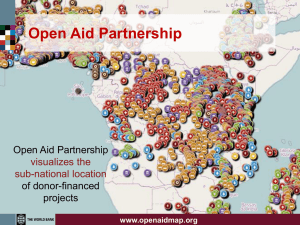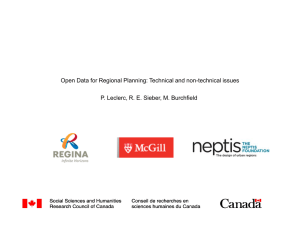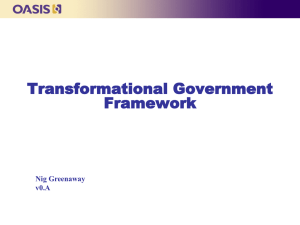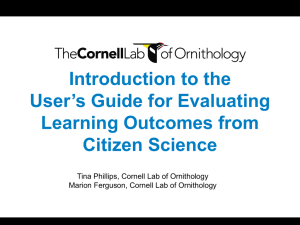view slides - Events
advertisement
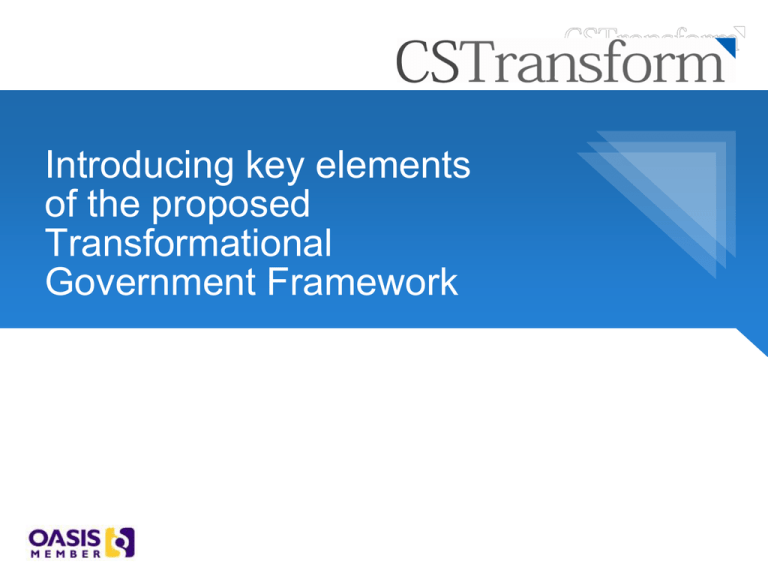
Introducing key elements of the proposed Transformational Government Framework The mandate of the OASIS Transformational Government Technical Committee •The major deliverable will be a Framework for Transformational Government. •Included in this Framework will be: –a Transformational Government Reference Model, –definitions of a series of policy products necessary to implement the change, –a value chain for citizen service transformation, –a series of guiding principles, –a business model for change, –a delivery roadmap, –and a checklist of critical success factors. •Supporting this Framework will be a number of Use Cases and other guidance advice on its adoption Citizen Service Transformation Our contribution to the debate The Citizen Service Transformation Value Chain Guiding Principles for Citizen Service Transformation Citizen-centric channel management Citizen-centric customer management Citizen empowerment Identity Management Marketing and branding Delivery Roadmap Policy Products Business Model Key service delivery process Vision > Strategy > Internet Walk-in DiTV Phone (and mobile device) Mail Front-line staff Channel Management Strategy Citizen-centric business management Service-oriented IT architecture Strategic clarity Critical success factors Citizen Service Transformation Skills Stakeholder engagement Future-proofing Benefit realisation Leadership User focus Supplier partnership Do-ability Lower cost Policy outcomes Impact Transformed customer experience Our contribution to the debate The Citizen Service Transformation Value Chain Guiding Principles for Citizen Service Transformation Citizen-centric channel management Citizen-centric customer management • I won’t go through this in detail Citizen empowerment Identity Management Marketing and branding Delivery Roadmap Policy Products Business Model Key service delivery process Vision > Strategy > Internet Walk-in DiTV Channel Management Strategy Citizen-centric business management • But will focus on three elements in Phone (and mobile device) Mail Lower cost Policy outcomes Impact Transformed customer experience particular that may be helpful as the TGF Front-line staff Service-oriented IT architecture work kicks off Strategic clarity Critical success factors Citizen Service Transformation Skills Stakeholder engagement Future-proofing Benefit realisation Leadership User focus Supplier partnership Do-ability Our contribution to the debate The Citizen Service Transformation Value Chain Guiding Principles for Citizen Service Transformation Citizen-centric customer management Citizen-centric channel management Critical success factors Citizen Service Transformation Citizen empowerment Identity Management Marketing and branding Delivery Roadmap Policy Products Business Model Key service delivery process Vision > Strategy > Internet Walk-in DiTV Phone (and mobile device) Channel Management Strategy Citizen-centric business management Lower cost Policy outcomes Impact Mail 1. Are there are a set of principles for Front-line staff Transformational Government which both Service-oriented IT architecture a) are universally applicable and b) are a Stakeholder Strategic clarity Skills meaningful guide for Future-proofing business change? engagement Benefit realisation Leadership User focus Supplier partnership Do-ability Transformed customer experience Our contribution to the debate The Citizen Service Transformation Value Chain Guiding Principles for Citizen Service Transformation Citizen-centric channel management Citizen-centric customer management Citizen empowerment Marketing and branding Identity Management Delivery Roadmap 2. Can we identify Critical Success DiTV Factors? Policy Products Business Model Key service delivery process Vision > Strategy > Internet Channel Management Strategy Citizen-centric business management Walk-in Phone (and mobile device) Mail Front-line staff Service-oriented IT architecture Strategic clarity Critical success factors Citizen Service Transformation Skills Stakeholder engagement Future-proofing Benefit realisation Leadership User focus Supplier partnership Do-ability Lower cost Policy outcomes Impact Transformed customer experience Our contribution to the debate The Citizen Service Transformation Value Chain Guiding Principles for Citizen Service Transformation Citizen-centric channel management Citizen-centric customer management Citizen empowerment Identity Management Marketing and branding 3. Does our Policy ProductLower framework Walk-in cost provide a helpfulDiTV approach toPolicy mapping outcomes Phone the areas on which the TGF should (and mobile device) Impact provideMailguidance? Delivery Roadmap Policy Products Business Model Key service delivery process Vision > Strategy > Internet Channel Management Strategy Citizen-centric business management Front-line staff Service-oriented IT architecture Strategic clarity Critical success factors Citizen Service Transformation Skills Stakeholder engagement Future-proofing Benefit realisation Leadership User focus Supplier partnership Do-ability Transformed customer experience Our contribution to the debate The Citizen Service Transformation Value Chain Guiding Principles for Citizen Service Transformation Citizen-centric channel management Citizen-centric customer management Citizen empowerment Identity Management Marketing and branding Delivery Roadmap Policy Products Business Model Key service delivery process Vision > Strategy > Internet Walk-in DiTV Phone (and mobile device) Mail Front-line staff Channel Management Strategy Citizen-centric business management Service-oriented IT architecture Strategic clarity Critical success factors Citizen Service Transformation Skills Stakeholder engagement Future-proofing Benefit realisation Leadership User focus Supplier partnership Do-ability Lower cost Policy outcomes Impact Transformed customer experience The Citizen Service Transformation Value Chain Guiding Principles Principles for for Guiding Citizen Service Service Transformation Transformation Citizen Critical success factors Citizen Service Transformation Citizen empowerment Identity management Marketing & branding 2. • customer management Citizen-centric channel management Own the customer at the whole-of-government level Don’t assume you know what your customers think – research, Internetresearch, research Invest in developing a real-time, event-level understanding of citizen Walk-in interactions with government Policy Products Key service delivery process Vision > strategy > Business model • • Citizen-centric understanding your customers DiTV Build services around customer needs, not organisational structure • • Channel management strategy Citizen-centric Be obsessive about business management Delivery Roadmap 1. Phone Provide people with one place to access government, built round their needs (and mobile device) Don’t try to restructure government to do this – build “customer franchises” Mail which sit within the existing structure of government and act as change agents • Deliver services across multiple channels – but usingFront-line web services staffto join it all up, reduce infrastructure duplication, and to encourage customers into lower cost channels • Don’t spend money on technology before addressing organisational and business change Stakeholder Service-oriented IT architecture Strategic clarity Skills Leadership User focus • Future-proofing Don’t reinvent wheels - buildengagement a cross-government strategy for common citizen Benefit data sets (eg name, address) and common citizen applications (egrealisation authentication, payments, notifications) Supplier partnership Do-ability Lower cost Policy outcomes Impact Transformed customer experience The Citizen Service Transformation Value Chain Guiding Principles Principles for for Guiding Citizen Service Service Transformation Transformation Citizen Engage citizens directly in service design and delivery • Give citizens the technology tools that enable them to create public value themselves Walk-in • • Citizen empowerment Give citizens ownership and control of their personal data – and make all nonDiTV personal data available for re-use and innovation by citizens and third parties Grow the market • Identity management Marketing & branding Internet Channel management strategy channel management • Delivery Roadmap 4. not to Citizen-centric them Policy Products Key service delivery process Citizen-centric Citizen service transformationCitizen-centric is done with citizens, business management customer management Vision > strategy > Business model 3. Phone Ensure that your service transformation plans are integrated with an effective (and mobile device) digital inclusion strategy to build access to and demand for e-services across Mail society Recognise that other market players often have muchFront-line greater influence on staff citizen behaviour than government – so build partnerships which enable the market to deliver your objectives Service-oriented IT architecture 5. Critical Critical success success factors factors Citizen Service Transformation Manage and measure the nine critical success factors Strategic Strategic clarity clarity Leadership Leadership Skills Skills User User focus focus Stakeholder Stakeholder engagement engagement Future-proofing Future-proofing Supplier Supplier partnership partnership Do-ability Do-ability Benefit Benefit realisation realisation Lower cost Policy outcomes Impact Transformed customer experience Critical Success Factors Guiding Principles for Citizen Service Transformation Draws on a wide range of government research Citizen-centric channel management Citizen-centric customer management Critical Critical success success factors factors Citizen Service Transformation Strategic Strategic clarity clarity Leadership Leadership Common Causes of Project Failure, OGC, 2005 Citizen empowerment Identity management Marketing & branding Successful IT: Modernizing Government in Action, Cabinet Office, 2000 Delivery Roadmap Policy Products Key service delivery process Vision > strategy > Business model Internet Walk-in DiTV Phone (and mobile device) Mail Review of the Australian Government's Use of 2008 Service-orientedICT, IT architecture Skills Skills User User focus focus Channel management strategy Citizen-centric business management The EU’s Breaking Front-line Barriers tostaff e-Government research programme Stakeholder Stakeholder engagement engagement Future-proofing Future-proofing Supplier Supplier partnership partnership Do-ability Do-ability Benefit Benefit realisation realisation Lower cost Policy outcomes Impact Transformed customer experience Critical Success Factors (1) Strategic clarity Clear vision: all programme stakeholders have a common and comprehensive view of what the programme is seeking to achieve. Strong business case: we know what outcomes we want to achieve, have baselined where we are now, and know how we will measure success. Focus on results: although we have a vision of where we want to go, and a set of principles by which we will move forwards, we do not over-plan. Instead, our strategy focuses on taking concrete, practical steps in the short to medium term, rather than continually describing the long-term vision. Strategic clarity Skills Stakeholder engagement Future-proofing Benefit realisation Leadership Citizen Service Transformation User focus Supplier partnership Do-ability Critical Success Factors (2) Leadership Sustained support: our political leaders and top management are committed to the programme for the long term. Leadership skills: our programme leaders have the skills needed to drive ITenabled business transformation, and have access to external support Collaborative governance: leaders from all parts of our and other organisations involved in the programme are motivated for it to succeed, and are engaged in clear and collaborative governance mechanisms to manage any risks and issues. Strategic clarity Skills Stakeholder engagement Future-proofing Benefit realisation Leadership Citizen Service Transformation User focus Supplier partnership Do-ability Critical Success Factors (3) User focus A holistic view of the customer: we understand who the customers for our services are – not just for individual services – but across the government as a whole. We know our customers, both internal and external, are different - and understand their needs on a segmented basis. Citizen-centric delivery: citizens can access all our services through a “one-stop” service. This is available over multiple channels, but we use web services to join it all up and reduce infrastructure duplication, and we actively encourage customers into lower cost channels. Citizen empowerment: we engage citizens directly in service design and delivery, and provide them with technology tools that enable them to create public value themselves Strategic clarity Skills Stakeholder engagement Future-proofing Benefit realisation Leadership Citizen Service Transformation User focus Supplier partnership Do-ability Critical Success Factors (4) Skills Skills mapping: we know that the mix of business change, product and marketing management, programme management, and technology skills needed to deliver transformational change does not already exist in our organisation. We have mapped out the skills we need, and have a clear strategy for acquiring them. Skills integration: we have effective mechanisms in place to maximum value from the skills available in all parts of our delivery team, bringing together internal and external skills into an integrated team. Strategic clarity Skills Stakeholder engagement Future-proofing Benefit realisation Leadership Citizen Service Transformation User focus Supplier partnership Do-ability Critical Success Factors (5) Stakeholder engagement Stakeholder communication: all our stakeholders – users, suppliers, delivery partners elsewhere in the public, private and voluntary sector, politicians, the media etc – have a clear understanding of our programme and how they can engage with it. Cross-sectoral partnership: other market players (in the private, voluntary and community sectors) often have much greater influence on citizen attitudes and behavior than government – so our strategy aims to build partnerships which enable the market to deliver our objectives. Strategic clarity Skills Stakeholder engagement Future-proofing Benefit realisation Leadership Citizen Service Transformation User focus Supplier partnership Do-ability Critical Success Factors (6) Supplier partnership Smart supplier selection: we select suppliers based on long-term value for money rather than price, and in particular based on our degree of confidence that the chosen supplier will secure delivery of the expected business benefits Supplier integration: we will manage the relationship with strategic suppliers at top management level, and ensure effective client/supplier integration into an effective programme delivery team with shared management information systems. Strategic clarity Skills Stakeholder engagement Future-proofing Benefit realisation Leadership Citizen Service Transformation User focus Supplier partnership Do-ability Critical Success Factors (7) Do-ability Phased implementation: we will avoid a “big bang” approach to implementation, reliant on significant levels of simultaneous technological and organisational change. Continuous improvement: we expect not to get everything right first time, but have systems which enable us to move quickly and learn from experience. Strategic clarity Skills Stakeholder engagement Future-proofing Benefit realisation Leadership Citizen Service Transformation User focus Supplier partnership Do-ability Critical Success Factors (8) Future-proofing Interoperability: we use interoperable, open standards which are well supported in the market-place. Web-centric delivery: we will use a service-oriented architecture to support all of our customer interactions, from face-to-face interactions by front line staff to online selfservice interactions Agility: we will deploy technology using common building blocks which can be re-used to enable flexible and adaptive use of technology to react quickly to changing customer needs and demands. Shared services: key building blocks will be managed as government-wide resources – in particular common data sets (eg name, address); common citizen applications (eg authentication, payments, notifications); and core IT infrastructure. Continuous improvement: we expect not to get everything right first time, but have systems which enable us to move quickly and learn from experience. Strategic clarity Skills Stakeholder engagement Future-proofing Benefit realisation Leadership Citizen Service Transformation User focus Supplier partnership Do-ability Critical Success Factors (9) Benefit realisation Benefit mapping: we ensure clear line of sight between every investment and the end outcomes we are trying to achieve Benefit tracking: we establish clear baselines, set measurable success criteria, and track progress against planned delivery trajectories for each of these Benefit delivery: we establish pro-active governance arrangements to drive out the downstream benefits after the initial implementation project is complete Strategic clarity Skills Stakeholder engagement Future-proofing Benefit realisation Leadership Citizen Service Transformation User focus Supplier partnership Do-ability Policy Products for Citizen Service Transformation The Citizen Service Transformation value chain Technology Customers Channels Business Political Interoperability Domains Organisational Legal Legal vires for inter- agency collaboration Legal framework for public private Governance model1,2,3 partnership Strategic Business Case for overall programme1 Cross-government vision for citizen service transformation Risk Management Strategy Pro-competitive regulatory E-Service take-up strategy framework for the Intermediaries policy communications sector Accessibility policies and compliance1 Digital Inclusion strategy Identity Management Strategy1 Data Sharing Policy1,2 eSignatures and e-Business enabling legislation1,2 Data protection and data security legislation1,2 Transformation Roadmap Key Services Portfolio1 Semantic Business case best Metadata Repository1,3 practice guidance1 Business Process Performance Funding model Model2,4 Measurement 2 Franchise Operating model Framework Logical Data Transformation Benefits Realisation model2,4 competency framework Plan1 Channel Integration Framework2 Channel Management Guidelines2,3 Federated trust model for cross-agency identity management1,2 Marketing and Communications strategy Cross-government customer segmentation framework Technical Technology Estate Map1 Technology Roadmap1 Information Preservation Framework1 Web Accessibility Guidelines1,3 Presentation Architecture4 Common data standards (especially for name, address, key personal attributes)1,2,3 Single-sign on Architecture3 Service definition for One-Stop Government service Brand Management guidelines Information Security Policy1,2,3 Procurement legislation1 Framework contracts1 Supplier management guidelines Service level agreements1 Physical data model4 Interoperability Framework1,3 Security Architecture1,3 Application Architecture4 Network Architecture4 Service-oriented Architecture1 Citizen Sources for reference models 1: European Interoperability Framework v1 draft, http://ec.europa.eu/idabc/en/document/2319/5644 2: US Federal Enterprise, Service Transformation Architecture www.whitehouse.gov/omb/e-gov/fea/ 3: UK GovTalk, www.govtalk.gov.uk 4: Zachmann, http://zachmaninternational.com/index.php/home-article Questions for discussion 1. Are there are a set of principles for Transformational Government which both a) are universally applicable and b) are a meaningful guide for business change? 2. Are we identifying the right Critical Success Factors? 3. Does the Policy Product framework provide a useful framework for the TGF to pursue? Citizen Service Transformation Thank you



